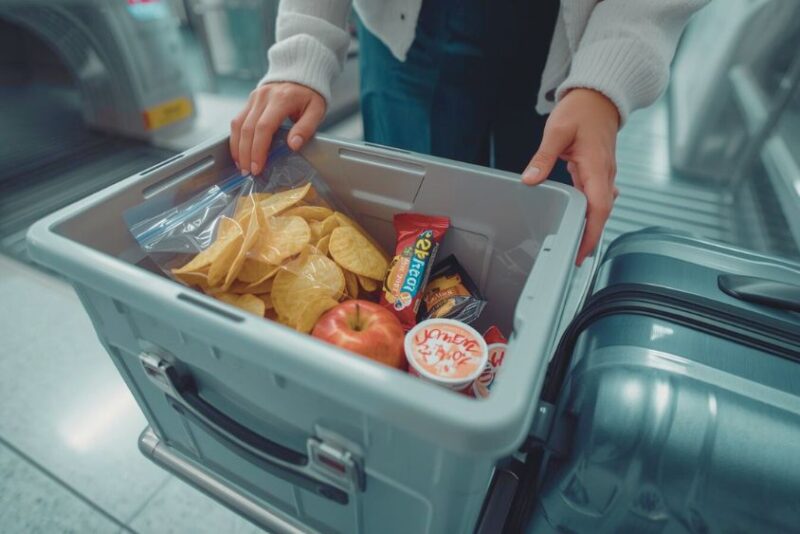If you’ve ever packed a sandwich or a bag of chips before heading to the airport, you’ve probably wondered: Can you actually bring snacks through TSA security?
Yes — you can. The TSA allows solid foods in both carry-on and checked bags. The only catch? Anything that can spread, pour, or squish — like hummus, peanut butter, yogurt, or soup — falls under the liquid rule (3.4 oz / 100 ml limit).
So why do travelers still get confused? Because “liquid food” is a gray area. Some foods look solid but technically count as gels. In this guide, we’ll break it down clearly — solid vs. liquid snacks, how to pack them, and even which foods might surprise you at the checkpoint.
Let’s start with what’s actually allowed past TSA scanners.
Can You Take Snacks Through Airport Security?

Yes — and in most cases, it’s easier than people think. The Transportation Security Administration (TSA) doesn’t mind snacks at all; what matters is texture.
Solid foods like chips, cookies, sandwiches, nuts, and whole fruit breeze through the X-ray belt. But once a food can be poured, spread, or sloshed, it joins the same category as shampoo — the 3-1-1 liquids rule applies.
Here’s the simple test:
If it can spill, it’s a liquid. If it can crumble, it’s a solid.
That means your granola bar? Fine.
Your yogurt cup or peanut butter jar? Not fine (unless it’s 3.4 oz / 100 ml or smaller).
Even soft cheese like brie or cream cheese counts as a spread, not a solid block.
To double-check any item, the TSA keeps an official public list called “What Can I Bring? — It’s updated frequently and is the single best source for edge cases like sauces, dips, or frozen foods.
Pro tip: If you’re flying with fresh fruit or veggies from Hawaii, Puerto Rico, or the U.S. Virgin Islands, U.S. Department of Agriculture rules (APHIS) restrict taking them to the mainland. You can confirm details on the APHIS traveler guidance.
Once you understand solids vs. liquids, the next question is where to keep them.
Let’s unpack what happens when you put those snacks inside your carry-on.
Can You Bring Snacks in Your Carry-On?
Absolutely — in fact, that’s the smartest way to do it. Carry-ons are where TSA expects to see food items, so you can keep your snacks close and avoid crushed sandwiches in checked luggage. The trick is organization.
When your bag goes through the X-ray, food often shows up as a dense blob. Officers may ask you to separate snacks into a tray for a clearer scan — especially if you’ve packed a mix of bars, fruits, and powders. A clear quart-size Ziplock or small pouch works perfectly for this.
If you travel often, using a well-designed carry-on like a TSA-friendly laptop backpack helps keep snacks, electronics, and liquids in their own sections so you can unzip, lay flat, and glide through security faster.
Quick tip: TSA PreCheck doesn’t change what’s allowed — it just means you may not need to remove food or laptops. Still, organizing your carry-on makes the process smoother for everyone in line.
What About Fast Food or Takeout?
Yep, you can bring it through TSA too — burgers, fries, pizza slices, even a burrito. As long as the food itself isn’t liquid or soupy, it passes security just fine. The only exception is drinks: anything over 3.4 ounces has to be finished or tossed before the checkpoint.
That said, airport etiquette matters. Strong-smelling meals (think tuna, curry, or fried garlic) can turn a cramped cabin into a sensory experiment no one asked for. If you’re bringing takeout, wrap it tightly and wait until you’re at your gate or on the plane to unwrap it.
Also, consider cabin comfort: greasy foods can leak, and sauces count as liquids. Keep napkins or small wipes handy, and pack items in sealed containers to avoid mess.
Flying with kids or a long layover? Bringing your own food often beats overpriced airport meals — just be courteous about when and where you eat.
Can You Bring Packaged Food (Like Chips or Candy)?
Totally. Sealed snacks are the least likely to cause trouble at security. Bags of chips, candy bars, trail mix, or even pre-packed sandwiches sail through the X-ray belt with barely a glance. TSA officers can see what they are — dry, solid, harmless.
If it’s factory-sealed or clearly solid, it’s good to go. That’s why you can also bring unopened granola packs, jerky, or crackers in both your carry-on and checked luggage. Just avoid canned foods like soups or beans; they’re technically liquids if there’s sauce inside.
To double-confirm any borderline snack, check TSA’s official What Can I Bring? – Food page — it lists every food type alphabetically, from apples to yogurt, so you can see what’s fine and what needs to follow the 3-1-1 rule.
Pro tip: keep unopened packaging intact until after screening. Open bags sometimes trigger bag checks if they look like loose powders or crumbs on the X-ray image.
What Snacks Are Not Allowed?
Here’s where most travelers get caught off guard — when “snack” quietly turns into “spread.”
TSA bans or limits any food that can ooze, smear, or spill, because it counts as a liquid or gel under the 3-1-1 rule. That means no giant tubs of hummus, jars of peanut butter, or yogurt cups bigger than 3.4 ounces.
Here are a few snacks that don’t make it past security unless they’re under the limit or frozen solid:
- Nut butters (peanut, almond, hazelnut)
- Hummus, guacamole, and dips
- Yogurt, pudding, and soup
- Soft cheeses (brie, cream cheese, ricotta)
- Sauces, dressings, and salsa
- Canned foods with liquid (like beans or stews)
Even peanut butter cups can fall into a gray area since the filling is technically creamy. TSA officers usually let small candy sizes pass, but it’s never guaranteed.
6 Tips For Packing Snacks Smoothly
A few smart packing habits can make airport security feel a lot less chaotic. Here’s how to glide through the checkpoint without losing your snacks — or your patience.
- Use clear bags or small containers. TSA likes transparency (literally). Keep snacks in resealable Ziplocks or clear pouches so officers can instantly see what’s inside.
- Keep snacks near the top of your bag. If you’re asked to remove food for screening, you can do it in seconds instead of digging past your laptop and charger cords.
- Separate wet or creamy foods. If you’re bringing small travel-size sauces or dips, put them in your liquids bag just like toiletries.
- Freeze what you can. Frozen foods are allowed if they’re completely solid at the time of screening — melted ice packs or half-frozen drinks count as liquids.
- Traveling with kids or infants? Baby food, breast milk, and formula are exceptions to the 3-1-1 rule. You can bring reasonable quantities — just declare them at security.
- Label powders. Protein mixes and meal replacements can confuse scanners if they exceed 12 ounces. Label or pre-portion them into smaller packets.
Bonus tip: Always wash or sanitize your hands before eating, especially after handling bins or trays. Clean travel habits keep you healthy on long journeys — more in Travel Safety 101: 22 Tips for a Secure Journey.
Frequently Asked Questions
Can I bring fruits on domestic flights?
Yes — fresh fruits are fine on flights within the continental U.S. Just remember, agricultural rules apply if you’re flying from Hawaii, Puerto Rico, or the U.S. Virgin Islands to the mainland, where certain fruits and vegetables aren’t allowed due to pest restrictions.
Are protein bars allowed through TSA?
Absolutely. Protein bars are solid foods, so they’re perfectly fine in your carry-on. If you’re bringing protein powder, keep it under 12 ounces (350 ml) or expect extra screening.
Can I bring peanut butter cups?
Usually yes, since they’re small and sealed — but the creamy filling technically counts as a liquid. TSA agents typically let snack-size pieces pass, though larger peanut-butter-filled items could be flagged.
Can I bring snacks for my baby?
Yes. TSA allows baby food, formula, breast milk, and toddler drinks in reasonable quantities above the 3.4-oz limit. Just remove them for inspection and tell the officer before screening.
Final Note
Flying with your favorite snacks doesn’t need to be stressful. As long as you follow the solid-vs-liquid rule and pack neatly, you can sail through TSA with chips in one hand and confidence in the other.
That’s it — simple, practical, and travel-friendly.
Want more quick answers like this? Check out our Travel FAQs Hub for more practical guides on what you can and can’t bring on a plane.
Happy travel!
